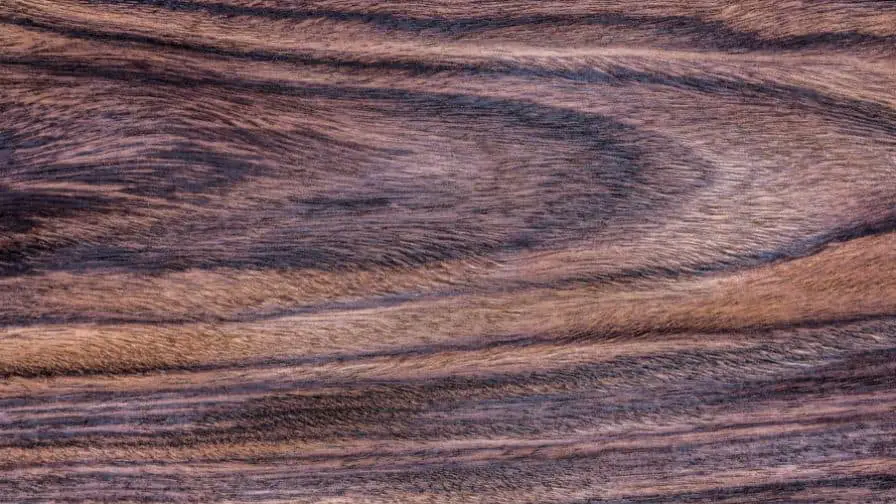
When it comes to Rosewood vs Walnut, there are a few things you need to consider. Both of these types of wood are popular choices for furniture and flooring, but they have different characteristics that might make one better suited for your needs than the other.
In this blog post, we will discuss the pros and cons of Rosewood vs Walnut so that you can make an informed decision about which one is best for you!
What Is Rosewood?
Rosewood is a red wood that is used for a variety of purposes, such as furniture and flooring. It is also a popular choice for carving and other decorative uses.
There are many varieties, but the best known is Dalbergia nigra which grows in Brazil, Bolivia, and Peru. Others grow in India. It has a strong, sweet smell which is why it’s often used in perfume. The heartwood is brown to black with dark streaks and a purple hue. The sapwood is white to pale yellow. The grain is straight to interlocked, and the texture is fine to medium.
Rosewood is one of the most expensive woods in the world due to its rarity, beauty, and durability. It’s often used in high-end furniture and musical instruments. When buying rosewood furniture, be sure to ask about the source of the wood to ensure it’s from a reputable source.
It is found in tropical regions of the world and has become a protected species due to over forestation.
Rosewood is often used as a veneer, meaning it is glued to another piece of wood to create a decorative effect.

Subscribe to Woodworkers Source on YouTube
What Is Walnut Wood?
Walnut wood is a type of hardwood that is typically used in the construction of furniture and cabinets. It is also a popular choice for floors and paneling. Walnut wood has a dark brown color with a straight grain pattern.
Walnut wood is available in two main types: black walnut and walnut. Black walnut is the more expensive of the two types.
Walnut wood is available in two different grades. Grade A walnut wood is the highest quality and is typically used in high-end furniture. Grade B walnut wood is of lower quality and is often used in lower-priced furniture or for construction purposes.
Walnut wood is a hardwood that is strong and durable. It is also resistant to warping and twisting. It is easy to work with and takes stain well.

ROSEWOOD VS WALNUT
| CATEGORY | ROSEWOOD | WALNUT WOOD |
| PRICE | The price of Rosewood varies depending on the quality of the lumber and can range from $9.00-$50.00/board foot depending on the Rosewood species and harvest location. You can order natural, high character and premium walnut boards. If you order in bulk you can get cheaper pricing. | The price of Walnut wood varies depending on the quality of the lumber and can range from $11.99-$20.99/board foot. You can order natural, high character and premium walnut boards. If you order in bulk you can get cheaper pricing. |
| JANKA HARDNESS | Bolivian Rosewood Janka Hardness is 1960 Honduras Rosewood Janka Hardness is 2200 East Indian Rosewood Janka Hardness is 2440 Amazon Rosewood Janka Hardness is 2620 | Walnut Janka Hardness is 1010 |
| DURABILITY | Rosewood’s durability makes it an ideal candidate for high-traffic areas or places where furniture might see a lot of wear and tear. | Walnut’s durability makes it ideal for furniture and cabinetry. |
| SPECIES | Rosewood species belong to the genus Dalbergia. There are many different species of rosewood, but the most popular ones used in furniture making are Brazilian Rosewood (Dalbergia nigra), Indian Rosewood (Dalbergia latifolia), and Cocobolo (Dalbergia retusa). | Walnut species is called Juglans and it belongs to the Juglandaceae family. |
| TREE SIZE | Rosewood trees can grow up to 100 feet and up to 36″ in diameter. Their leaves are evergreen, and the tree produces small, white flowers. | Walnut trees are generally smaller, averaging between 20 and 60 feet tall with a spread of 50-75 feet. Walnut tree leaves are larger, darker green, and have a rough texture. Walnut trees have a more rounded canopy. |
| LOCATION | Rosewood trees are native to South America, Central America, Africa and the West Indies. | Walnut trees are native to the Mediterranean region but are also grown in other parts of the world including North America, Europe, and Asia. Walnut trees prefer a temperate climate with well-drained soil. |
| COLOR | Rosewood’s heartwood can vary depending on location from reddish brown to orange to even black. The sapwood is a creamy white. | Walnut wood is typically a chocolate brown color with darker streaks running through it. Walnut wood may also have a slightly purple hue to it. Walnut, on the other hand, has a more consistent color. It is usually a dark chocolate brown but can also be found in lighter shades. Walnut blossoms are greenish-yellow. |
| GRAIN | Rosewood grain is usually straight with a medium to course texture. You will find some areas of interlocking grain, but this is not as common as with walnut. The grain on walnut is also generally finer than that of rosewood. | Walnut wood grain is straight grained and pores are much larger and more spaced out. Walnut wood grain is more open with a looser feel and a rough texture. |
| END GRAIN | Rosewood’s End Grain is diffuse porous with a medium to fine texture. It’s grain is interlocked, with a moderate natural luster. | Walnut End Grain is smooth, with small, uniform pores arranged in a spiral pattern. Walnut on the other hand is a softer more open grained wood that will show knife marks more readily. Walnut also has a limited range of colors and grain patterns. |
| ROT RESISTANCE | Rosewood has a high level of rot resistance because of it’s density and also resistance to insect infestations. | Walnut’s rot resistance is due to the chemical properties of juglone and its low density. Walnut is a relatively soft wood, and its low density makes it more difficult for decay-causing fungi to penetrate the wood. |
| SUSTAINABILITY | Rosewood is a protected species and is not sustainably grown. | Walnut trees can be harvested after reaching maturity between 40-60 years old. It is not as sustainable because it is a less common resource and takes longer to grow. |
| USES | Rosewood can be used for a number of things. For example, it can be used for veneer, musical instruments, turned objects, and inlay work. | Walnut wood can be used for furniture, cabinetry, gunstocks, veneers, interior paneling, cutting boards, marquetry inlays, checkboards, flooring, millwork, desks, dining tables and butcher blocks. |
| RELATED SPECIES | Rosewood related species are mainly found in the tropical regions of Central and South America, Madagascar and Asia. There about 300 species under the Rosewood family. | Walnut related species are found mostly in the southern hemisphere but some grow in the northern hemisphere as well. There are about 30 related species of walnut including black walnut, butternut, and heartnut. walnuts are evergreen. |
ROSEWOOD VS WALNUT: PROS & CONS
| ROSEWOOD | WALNUT | |
| PROS | The pros of Rosewood are that it is an excellent tonewood. Rosewood has a very full, rich sound and is very resonant. It is also a very hard and dense wood, which makes it durable. | The pros of Walnut wood are that it is very strong and durable. Walnut is also a popular choice for furniture because it has a beautiful grain pattern. Walnut can be stained or painted to match any decor. |
| CONS | The cons of Rosewood are that it can be difficult to work with, it is quite expensive and it is a non-sustainable protected species. | The cons of Walnut are that it is susceptible to scratches and dents. Walnut is also a bit more expensive than some other types of wood. |
Rosewood is best for:
-Musical Instruments
-Trim
-Mantles
-Veneer
-Guitars
If you’re looking for high quality wood for musical instruments, trim, mantles or guitars, rosewood is the best option. It’s strong and durable, yet still has a beautiful grain that makes it perfect for these applications.

Walnut Wood Is Best For:
-Making high-quality furniture
-Creating beautiful floors
-Constructing cabinets and other storage solutions
If you’re looking for a wood that will give your home a luxurious look and feel, then walnut is the way to go. This type of wood is often used in high-end furniture and flooring, as it has a rich, dark color that really makes a statement.
It’s also perfect for constructing cabinets and other storage solutions, as it is both strong and stylish. So if you’re looking to add a touch of luxury to your home, then walnut wood is the way to go.

What Wood Looks Similar To Rosewood?
There are a few wood species that have a similar appearance to rosewood. These include:
- Bubinga: Bubinga is a hardwood that grows in Africa. It has a reddish brown color with dark streaks running through it. Bubinga is often used for furniture, musical instruments, and veneers.
- Padauk: Padauk is a reddish brown wood that grows in Africa and Asia. It has a straight grain with a fine texture. Padauk is often used for furniture, flooring, and turnings.
- Wenge: Wenge is a dark brown wood that grows in Africa. It has a very straight grain with a coarse texture. Wenge is often used for furniture, musical instruments, and veneers.
- Zebrawood: Zebrawood is a hardwood that grows in Africa. It has a yellowish brown color with dark streaks running through it. Zebrawood is often used for furniture, flooring, and veneers.
If you are looking for a wood that has a similar appearance to rosewood, these are a few of the best options. Each one has a unique grain pattern and color that will give your project an amazing look.
Subscribe to Rob Pelc on YouTube



